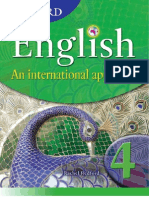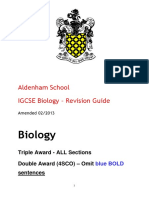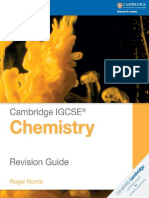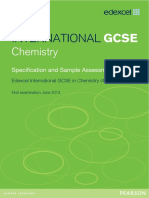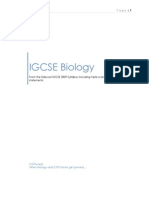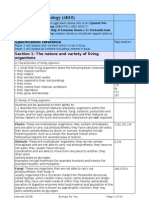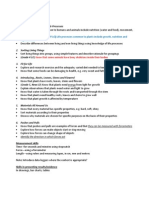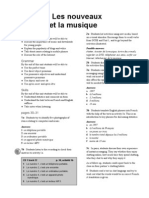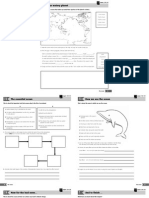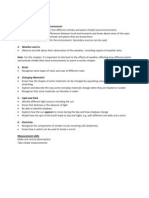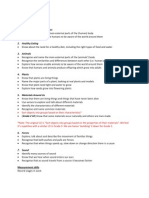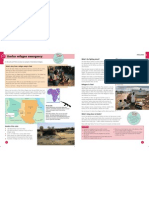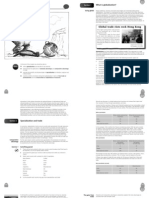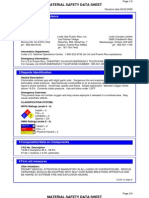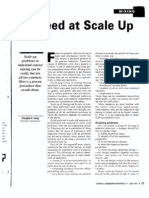9780199138760
9780199138760
Uploaded by
eibsourceCopyright:
Available Formats
9780199138760
9780199138760
Uploaded by
eibsourceCopyright
Available Formats
Share this document
Did you find this document useful?
Is this content inappropriate?
Copyright:
Available Formats
9780199138760
9780199138760
Uploaded by
eibsourceCopyright:
Available Formats
Now even more comprehensive - and with a free student CD-ROM!
Endorsed by University of Cambridge International Examinations
This new second edition provides full coverage of the most recent Cambridge IGCSE Biology syllabus in a highly illustrative and accessible way. It also comes with a free CD to stretch your most able pupils and is now supported by a Teachers Resource Kit. A free student CD contains even more material to stretch your students, including revision support, past exam questions, model answers, repeated questions from the Student Books and more Full colour, student-friendly design caters to all learning types, with plenty of diagrams, charts and visuals to explain challenging concepts A step-by-step approach simplifies difficult concepts, easing comprehension Uses clear, straightforward English, ensuring clarity for your EAL students Plenty of case studies on relatable, internationally-focused issues help students understand the importance of their learning By Ron Pickering, an experienced author, written specifically for the international classroom Companion Teachers Resource Kit and Revision Guide also available to provide additional support and optimally prepare students for exam success
We care deeply about global access to high quality education. We collaborate closely with Oxford University Press to develop valuable resources which meet the needs of teachers and students all over the world, and are pleased to endorse Oxford resources for Cambridge IGCSE. .
Ann Puntis, Chief Executive University of Cambridge International Examinations
Characteristics and classification of living organisms 1.1 Biology is the study of life and living organisms 1.2 The variety of life 1.3 Bacteria and viruses 1.4 Fungi 1.5 Plants 1.6 Invertebrate animals 1.7 Vertebrate animals: five classes Organisation and maintenance of organisms 2.1 Organisms are made up of cells 2.2 The organisation of living organisms 2.3 Movement in and out of cells 2.4 Enzymes control biochemical reactions in the living organisms in living organisms 2.5 Humans use enzymes from micro-organisms 2.6 Enzyme experiments & the scientific method 2.7 All living things are made up of organic molecules 2.8 Testing for bio chemicals 2.9 Food and the ideal diet: carbohydrates, lipids and proteins 2.10 Food and the ideal diet: vitamins, minerals, water and fibre 2.11 Food from micro-organisms 2.12 Using fungi to produce antibiotics 2.13 Baking and brewing: the economic importance of yeast 2.14 Food is the fuel that drives the processes of life 2.15 Balancing energy intake and energy demand 2.16 Malnutrition and famine 2.22 Plants and minerals 2.17 Photosynthesis and plant nutrition 2.18 The rate of photosynthesis 2.19 The leaf and photosynthesis
2.20 The control of photosynthesis 2.21 Photosynthesis and the environment 2.27 Uptake of water and minerals by roots 2.28 Transport systems in plants 2.29 Transpiration: water movement in plants 2.30 The leaf and water loss 2.31 Transport systems in animals 2.32 Combating infection 2.33 Antibodies and the immune response 2.34 The circulatory system 2.35 Capillaries 2.36 The heart is the pump for the circulatory system 2.37 Control of blood pressure and exercise 2.38 Coronary heart disease 2.39 Respiration provides the energy for life 2.40 Contraction of muscles and respiration 2.41 The measurement of respiration 2.42 Gas exchange supplies oxygen for respiration 2.43 Breathing ventilates the lungs 2.44 Smoking and disease 2.45 Excretion 2.46 Dialysis and the treatment of kidney failure 2.47 Homeostasis: maintaining a steady state 2.48 Control of body temperature 2.49 Coordination: the nervous system 2.50 Neurones can work together in reflex arcs 2.51 Muscles can work as effectors 2.52 The brain is the processor for the central nervous system 2.53 Integration by the central nervous system 2.54 Receptors and senses 2.55 The endocrine system 2.56 Drugs and disorders of the nervous system 2.57 Sensitivity and movement in plants: tropisms
Development of organisms and the continuity of life 3.1 Reproduction and living organisms 3.2 Reproduction in flowering plants 3.3 Pollination 3.4 Fertilisation & the formation of seed and fruit 3.5 Dispersal of seeds and fruits 3.6 Germination of seeds 3.7 Vegetative propagation 3.8 Artificial propagation 3.9 Reproduction in humans 3.10 The menstrual cycle 3.11 Copulation and conception 3.12 Contraception 3.13 Pregnancy: the role of the placenta 3.14 Pregnancy: development and antenatal care 3.15 Birth and the newborn baby 3.16 Sexually transmitted diseases 3.17 Growth and development 3.18 Variation and inheritance 3.19 Cell division 3.20 Inheritance 3.21 Studying patterns of inheritance 3.22 Inherited medical conditions and co- dominance 3.23 Sex is determined by X and Y chromosomes 3.24 Variation 3.25 Causes of variation 3.26 Variation and natural selection 3.27 Natural selection 3.28 Artificial selection 3.29 Genetic engineering 3.30 Gene transfer in plants and animals
Organisms and their environment 4.1 Ecology and ecosystems 4.2 Flow of energy: food chains and food webs 4.3 Feeding relationships 4.4 Decay is a natural process 4.5 The carbon cycle 4.6 The nitrogen cycle 4.7 Water is recycled too! 4.8 Factors affecting population size 4.9 Human population growth 4.10 Humans and agriculture 4.11 Land use for agriculture 4.12 Pollution of water: eutrophication 4.13 Human impacts on the environment 4.14 Humans may have a positive effect on the environment: conservation of species 4.15 Conservation efforts worldwide 4.16 Conservation of resources 4.17 Management of solid waste 4.18 Saving fossil fuels: fuel from fermentation Practical biology 5.1 Practical assessment 5.2 Laboratory equipment 5.3 Questions with practical content Index
ORGANISMS AND THEIR ENVIRONMENT
4.1
OBJECTIVES
Q
Ecology and ecosystems
living organisms and some are abiotic the non-living components of the habitat. Ecology is the study of living organisms in relation to their environment. The interactions between the organism and its environment are summarised below.
To understand that living organisms require certain conditions for their survival Q To understand that living organisms interact with one another, and with their non-living environment Q To dene population, community and ecosystem Q To realise that available resources change through the year
Changing with the seasons
The ability of the habitat to supply living organisms with their requirements may vary at different times of year. The ecosystem in the photograph opposite will only exist for a certain period of time as food or water becomes exhausted some animals may leave. These will then be followed by the predators which feed on them. The great animal migrations seen in East Africa result from the changing conditions in the animals environment, for example: Q poor rain means little growth of grass Q herbivores leave for areas of fresh growth Q carnivores follow herbivores Q (then scavengers follow carnivores!).
Environmental survival kit
All living organisms depend upon their environment for three survival essentials. These are a supply of food, shelter from undesirable physical conditions and a breeding site. The living organism interacts with its environment for example, a living plant: Q removes carbon dioxide, water and light energy from its habitat Q may be eaten by an animal or a parasite Q depends upon soil for support. Factors in the environment affect the growth of the plant. Some of these factors are biotic other
Carbon dioxide
Living together
Living organisms normally exist in groups. The names given to these groups, and the way they interact with the abiotic environment, are explained opposite.
A living organism interacts with its environment
Fertiliser in faeces
Food
Abiotic (non-living) factors
Biotic (living) factors e.g. predators food mates
Water and mineral ions from soil
A giraffe feeds on a thorn tree. The tree requires water, mineral ions, carbon dioxide and light to grow. The giraffe may provide carbon dioxide from respiration, and ions from decomposition of its faeces.
Physical e.g. oxygen and carbon dioxide concentration light intensity water availability
Climatic e.g. temperature humidity
246
ORGANISMS AND THEIR ENVIRONMENT
A population is all of the members of the same species (e.g. wildebeest) in a particular area.
A community is all of the populations of living organisms in one area (e.g. acacia trees, zebra, wildebeest and grass). The community is the biotic environment.
Air, water and soil make up the abiotic environment.
An ecosystem is all the living organisms and the non-living factors interacting together in a particular part of the environment.
A habitat is a part of the environment that can provide food, shelter and a breeding site for a living organism (e.g. a patch of grassland).
S Organisms exist in groups within an ecosystem
Q
1 Dene the terms population, community and ecosystem. 2 Name two abiotic factors that might determine whether or not a habitat is suitable for a living organism. 3 Suggest two ways in which a plant and an animal in the same habitat may interact. 4 What must a habitat provide? Ho 5 How are the following observations related?
Q Very few ying insects are found in Britain during
The pupils measured the amount of sunlight reaching each layer at different times in the year. Their results are shown on the graph.
Light intensity
Light reaching tree layer Light reaching ground layer Jan Feb Mar Apr May Jun Jul Aug Sep Oct Nov Dec Month
the winter.
Q Swallows migrate to Africa when it is winter in the UK. Q Hobbies (small bird-eating falcons) leave Britain in
late autumn. 6 What is meant by the term ecology? 7 a A group of pupils were studying a forest.They noticed that the plants grew in two main layers. They called these the tree layer and the ground layer.
tree layer
During which month did most light reach the tree layer? ii During which month did most light reach the ground layer? iii Suggest why the amount of sunlight reaching the ground layer is lower in mid-summer than in the spring. b The pupils found bluebells growing in the ground layer. Bluebells grow rapidly from bulbs. They ower in April and by June their leaves have died. i Suggest why bluebells grow rapidly in April. ii Suggest why the bluebell leaves have died by June.
ground layer
247
ORGANISMS AND THEIR ENVIRONMENT
4.2
OBJECTIVES
Q
Flow of energy: food chains and food webs
lost but is converted into some other form. During respiration, some energy is transferred to the environment as heat. The ow of energy through a food chain, and the heat losses to the environment, are illustrated in the diagram opposite.
To know that the feeding relationships in an ecosystem can be expressed as food chains Q To understand why energy transfer through an ecosystem is inefcient Q To understand why complex food webs are the most stable
Food webs Food chains
The most obvious interaction between different organisms in an ecosystem is feeding. During feeding, one organism is obtaining food energy and raw materials from another one. Usually one organism eats another, but then may itself be food for a third species. The ow of energy between different organisms in the ecosystem can be shown in a food chain, as in the diagram below. Since so little energy is transferred from the base to the top of a food chain, a top carnivore must eat many herbivores. These herbivores are probably not all of the same species. In turn, each herbivore is likely to feed on many different plant species. All these interconnected food chains in one part of an ecosystem can be shown in a food web. The more complicated a food web, the more stable the community is. For example, in the forest food web shown opposite, if the number of squirrels fell, the owls could eat more worms, mice and rats. The mice and rats would have less competition for food from squirrels, and so might reproduce more successfully.
Energy transfer is inefficient
The amount of energy that is passed on in a food chain is reduced at every step. Since energy can be neither created nor destroyed, it is not
Sunlight provides the energy to drive the food chain.
Consumers are organisms that obtain Producers, usually green plants, food energy from other organisms. can convert light energy to chemical energy in food compounds. Primary consumers are herbivores. They obtain their energy in food compounds obtained from producers (i.e. plants).
Secondary consumers are carnivores. They obtain their energy in food compounds obtained by eating other animals.
Arrows point in the direction of energy ow along the food chain. Decomposers, fungi and many bacteria, obtain their energy and raw materials from the wastes (e.g. faeces) and remains (e.g. dead bodies) of other organisms.
Secondary consumers may be eaten by tertiary consumers. These longer food chains are more common in aquatic habitats. The nal consumer in the food chain is called the top carnivore.
248
S Food chains show energy ow through an ecosystem. The position of each organism in the food chain represents a different trophic (feeding) level.
ORGANISMS AND THEIR ENVIRONMENT
Energy transfer
Less than 1% of the energy released from the Sun falls onto leaves.
Respiration losses occur from each trophic level. Respiration is not 100% efcient and eventually all of this energy is lost as heat.
Because of this, food chains rarely have more than 4 or 5 trophic levels.
Energy xed by producers is only 58% of the energy that falls onto their leaves, because: some is transmitted (passes right through) some is reected some is not the correct wavelength (only red or blue light is absorbed see page 64).
Key R respiration
Energy transfer to primary consumer is only 510%: much of plant body is indigestible consumer rarely eats whole plant roots or stems may be left behind.
Energy transfer to secondary consumer is between 10% and 20%: animal material has a higher energy value animal material is more digestible.
Note that energy ow is not cyclic!
sunlight
chemical bond heat energy As a result there must be a continuous input of light energy to drive life in an ecosystem.
Energy transfer to decomposers is very variable, but eventually the entire energy content of the animal and plant remains will be released as heat from inefcient respiration.
It is more efcient for humans to eat plants than to feed plants to animals, and then to eat the animals. Every step in the chain loses 8090% of the available energy as heat, so THE FEWER STEPS THE BETTER!
A simple forest food web
Trophic level Tertiary consumer
Q
Hawk
Secondary consumers
Starling
Owl
Primary consumers
Snails Woodlice
Worms
Rats
Mice
Squirrels
1 Dene the terms producer, consumer and decomposer. Which of these could be omitted from an ecosystem? Explain your answer. 2 Write out a food chain from a named ecosystem which you have studied. Wh 3 Why are food chains usually restricted to three or four res trophic levels?
Producers
Fallen leaves
Living leaves
Grasses
Seeds
249
4.2 Flow of energy: food chains and food webs
More examples of feeding relationships
Food chains and food webs in aquatic (watery) environments can be longer than those on the land. This is because this type of environment has space and ideal growth conditions for many producers. Even with energy losses at every stage there is enough trapped energy for more steps in the chain. Many of these food chains begin with phytoplankton (tiny green plants) or algae.
A freshwater food chain
Algae (small green plants)
Water eas
Guppy (small sh)
Bass (large sh)
Green heron
A seashore food chain
Algae on rocks (seaweed) Crabs Limpets Gull
The seashore is an excellent environment for animals, at least as far as food is concerned, because fresh supplies are delivered with every tide! Some of the top predators on seashores need so much food that they need to travel between different parts of the habitat. A gull, for example, might have to y to several different parts of the same shore.
Q
1 Look at the three aquatic feeding relationships shown on this page and the next. Make a table like this one:
Producers Herbivores Carnivores Top carnivores
Sh 2 Shark shing is a popular sport. Explain what might happen if all of the sharks living around a section of reef were captured by shermen. cap
250
ORGANISMS AND THEIR ENVIRONMENT
Coral reef food web
The most complex food webs are found in the ocean.
Shark
Octopus
Sea Turtle
Crab Butterysh
Parrotsh
Anemone
Jellysh
Coral
Zooplankton Phytoplankton
Q
3 Use words from the following list to complete the paragraph about ecosystems. You may use each word once, more Us than once or not at all. tha
decomposition, producer, chemical, carnivore, consumer, photosynthesis, energy, light, elements, decomposers, herbivore. In each ecosystem there are many feeding relationships. A food chain represents a ow of through an ecosystem, and always begins with an organism called a which is able to trap energy and convert it to energy. An organism of this type is eaten by a , which is a kind of that feeds only on plant material. This type of organism is, in turn, eaten by a (an organism that consumes other animals).
251
ORGANISMS AND THEIR ENVIRONMENT
4.3
OBJECTIVES
Q
Feeding relationships: pyramids of numbers, biomass and energy
Food chains and food webs provide qualitative information about an ecosystem they show which organism feeds on which other organism. How do we show quantitative information, for example how many predators can be supported by a certain number of plants at the start of the chain? We can use a pyramid of numbers or a pyramid of biomass, as shown in the diagram below.
To be able to describe pyramids of numbers, biomass and energy Q To understand how data can be gathered to make ecological pyramids
Pyramids of numbers
Look at the food chain on page 248. Two things should be clear: Q The organisms tend to get bigger moving along the food chain. Predators, such as the cat, need to be large enough to overcome their prey, such as the mouse. Q Energy is lost as heat on moving from one trophic level to the next, so an animal to the right of a food chain needs to eat several organisms below it in order to obtain enough energy. For example, a rabbit eats many blades of grass.
Pyramid of numbers a diagrammatic representation of the number of different organisms at each trophic level in an ecosystem at any one time Note 1 The number of organisms at any trophic level is represented by the length (or the area) of a rectangle. 2 Moving up the pyramid, the number of organisms generally decreases, but the size of each individual increases.
Pyramids of energy
A pyramid of biomass describes how much biomass is present in a habitat at the time the sample is taken. This can be misleading, because different feeding levels may contain organisms that reproduce, and so replace themselves, at different rates. For example, grass in a eld would replace itself more quickly than cattle feeding on the grass, so when the pyramid of biomass is constructed there would be more cattle biomass than grass
Top carnivore Small carnivore Herbivore Producers But wait!
Problems a The range of numbers may be enormous 500 000 grass plants may only support a single top carnivore so that drawing the pyramid to scale may be very difcult. b Pyramids may be inverted, particularly if the producer is very large (e.g. an oak tree) or parasites feed on the consumers (e.g. bird lice on an owl).
Bird lice Tawny owl Blue tits Insect larvae Oak tree So
Pyramid of biomass which represents the biomass (number of individuals mass of each individual) at each trophic level at any one time. This should solve the scale and inversion problems of the pyramid of numbers.
Bird lice Tawny owl Blue tits Insect larvae Oak tree
Biomass expressed as units of mass per unit area (e.g. kg per m2)
252
S Ecological pyramids represent numerical relationships between successive trophic levels. The pyramid of biomass is useful because the biomass gives a good idea of how much energy is passed on to the next trophic level.
ORGANISMS AND THEIR ENVIRONMENT
biomass and the pyramid would be inverted. To overcome this difculty a pyramid of energy can be constructed. This measures the amount of energy owing through an ecosystem over a period of time. The time period is usually a year, since this takes into account the changing rates of growth and reproduction in different seasons. It is even possible to add an extra base layer to the pyramid of energy representing the solar energy entering that particular ecosystem. GATHERING DATA FOR ECOLOGICAL PYRAMIDS
To construct a pyramid of numbers or of biomass, organisms must be captured, counted and (perhaps) weighed. This is done on a sample (a small number) of the organisms in an ecosystem. Counting every individual organism in a habitat would be extremely time-consuming and could considerably damage the environment. The sample should give an accurate estimate of the total population size. To do this:
Q The sampling must be random to avoid any bias. For
S Pyramid of energy: energy values are expressed as units of energy per unit area per unit time (e.g. kJ per m2 per year)
Wing nut
1m
Wire
20 cm 20 cm
example, it is tempting to collect a large number of organisms, by looking for the areas where they are most common. To avoid this, the possible sampling sites can each be given a number and then chosen using random number generators on a computer.
Q The sample must be the right size so that any 1m
Metal or wooden frame
A quadrat is a square frame made of wood or metal. It is simply laid on the ground and the number of organisms inside it is counted. A quadrat is used most commonly for estimating the size of plant populations, but may also be valuable for the study of populations of sessile or slow-moving animals (e.g. limpets).
rogue results can be eliminated. For example, a single sample might be taken from a bare patch of earth, whereas all other sites are covered with vegetation. The single sample from the bare patch should not be ignored, but its effects on the results will be lessened if another nine samples are taken. A mean value can then be used.
Sampling plants and sessile animals
Once the organisms in a sample have been identied and counted, the population size can be estimated. For example, if 10 quadrats gave a mean of 8 plants per quadrat, and each quadrat is one-hundredth of the area of the total site, then the total plant population in that area is 8 100 800.
253
ORGANISMS AND THEIR ENVIRONMENT
4.4
OBJECTIVES
Q
Decay is a natural process
Decomposition by microorganisms
The remains that are left are decomposed by the feeding activities of microorganisms. These fungi and bacteria feed by secreting enzymes onto the remains and absorbing the digested products. This form of nutrition is called saprotrophic feeding (see page 12). The diagram on the opposite page illustrates some of the features of the decomposition process. The decay process provides energy and raw materials for the decomposers. It also releases nutrients from the bodies of dead animals and plants, which can then be reused by other organisms, for example:
To understand that nutrients in dead organisms are recycled Q To know that the process of decay often begins with the activities of scavengers Q To know how saprotrophic nutrition is responsible for decomposition
Recycling nutrients
Humans have an unusual skill they can modify their environment to suit themselves. For example, we cut down forests and plant crops, and we build houses. Many building materials are natural, such as wood and straw, and the environment treats these materials as the dead remains of once-living organisms the environment reclaims the nutrients and returns them to the ecosystem.
sugar in dead rabbit
respiration by microorganisms
carbon dioxide
photosynthesis in plant
Starting with scavengers
When an organism dies, the nutrients in its body are returned to the environment to be reused. The nutrients are recycled by a series of processes carried out by other living organisms. The rst ones to appear are usually the scavengers which break up the dead bodies into more manageable pieces. Scavengers eat some of the dead body, but leave behind blood or small pieces of tissue.
sugar in plant In this way substances pass through nutrient cycles as microbes convert them from large, complex molecules in animal and plant remains to simpler compounds in the soil and the atmosphere. The next sections describe the recycling of the elements carbon and nitrogen.
Importance of decomposition processes to humans
Q Organic waste in sewage is decomposed and made
safe in water treatment plants (see page 284).
Q Organic pollutants such as spilled oil may be removed
S Scavengers such as the vulture feed on dead bodies
from the environment by decomposing bacteria (see page 11). Q Food is spoiled due to decomposition by fungi and bacteria. Many food treatments alter physical conditions to inhibit enzyme activity. Q Wounds may become infected by saprotrophs, leading to tissue loss or even to death. Many medical treatments inhibit the multiplication or metabolism of saprotrophs.
254
ORGANISMS AND THEIR ENVIRONMENT
Saprotrophs cause decay.
Cytoplasm Cells of saprotrophs (bacteria and fungi) nourish themselves by secreting enzymes onto food and absorbing the products.
Cell wall
Complex organic compounds include fats, proteins and starches.
Lipases fats fatty acids + glycerol
Metabolism inside the bacterial or fungal cells uses the absorbed products for respiration or for cell growth and division.
Amylase starch maltose glucose
Environmental factors may affect decomposition*
Absorbed simple compounds
Proteases protein amino acids
Antiseptics and disinfectants kill the living organisms that carry out the decay process. Good news! in hospitals and for food preservation but Bad news! in compost heaps and in sewage works.
Absorption by diffusion and/or by active transport. Simple compounds include fatty acids, glucose, amino acids and mineral salts.
*Heat for rapid decomposition, need to maintain an optimum temperature for the activity of enzymes. Heat is generated by the respiration that occurs during the decomposition process.
*Oxygen is required for aerobic respiration, which releases energy in bacteria and fungi to drive their metabolism. In the absence of oxygen decomposition is slow and very smelly, as methane and hydrogen sulde may be produced.
*Water many decomposition reactions are hydrolysis reactions, i.e. they use water to split chemical bonds. Water is also necessary to dissolve the breakdown products before they can be absorbed by the saprotrophs or other organisms.
Q
1 Copy and complete the following paragraph. During the process of decay, and convert complex chemicals into ones. For example, proteins are converted to , and to fatty acids and glycerol. These decay processes involve the biological catalysts called , and so the processes are affected by changes in and . Humans exploit decay, for example in the treatment of to provide drinking water, and may deliberately limit decay, for example in the preservation of .
Gardeners often place vegetable waste on a compost 2 Ga heap. Over the course of time the waste will be he decomposed. a What do gardeners gain from the decomposed waste? b Why do gardeners sometimes spray water over the heap in warm summer weather? c Why do gardeners often build compost heaps on a pile of loose-tting sticks or bricks?
255
ORGANISMS AND THEIR ENVIRONMENT
Questions on human impacts on ecosystems
1 The graph below shows changes in the population of bacteria that take place in a river when untreated sewage is added to it. d It is important that the wild dog species is conserved. i Explain the meaning of the term conservation. ii Outline the measures that could be taken to conserve a mammal, such as the wild dog. e When wild dogs die, nitrogen compounds in their bodies may become available for plants. Outline the processes that occur to make these nitrogen compounds in the bodies of dead animals available for plants to absorb.
Cambridge IGCSE Biology 0610 Paper 3 Variant 1 Q2 May 2008
population of bacteria (abitrary units)
raw sewage discharged into river
distance downstream (abitrary units)
3 Th freshwater mussel, Margaritifera margaritifera, The
a Describe the changes in the population of bacteria that take place in this river. b Suggest an explanation for these changes in the population of bacteria.
Cambridge IGCSE Biology 0610 Paper 2 Q8 May 2008
2 Th wild dog is one of the smaller African The
ca carnivorous mammals. It has disappeared from 25 of the 39 countries where it used to live. Wild dogs hunt in packs, feeding on antelopes, which are grass-eating mammals. A conservation programme has been started to increase the wild dog population in South Africa. Farmers are worried about numbers getting out of control because wild dogs breed at a very fast rate. However, conservationists are not concerned because the lion is a natural predator of the dogs. a Wild dogs are carnivorous mammals. i Dene the term carnivore. ii State one external feature which distinguishes mammals from other vertebrates. b i Suggest two reasons why numbers of African wild dogs are decreasing. ii Suggest what could happen to the species if numbers continue to decrease. c Using the information in the passage above, construct a food chain for a wild dog, including its predator. Label each organism with its trophic level.
is a mollusc which lives in rivers and streams. When the mussel reproduces, gametes are released into the water and fertilisation takes place. The embryos, in the form of larvae, attach themselves to the gills of sh and develop there for a few months. The larvae then release themselves and grow in sand in the river, feeding by ltering food from the water. The number of mussels is falling due to human predation and the species is threatened with extinction. a The mussel belongs to the group known as the molluscs. State two features you would expect the mussel to have. b Explain how the species name of the freshwater mussel can be distinguished from its genus. c State the type of reproduction shown by the mussel. Explain your answer. d i Fish gills have the same function as lungs. Suggest one advantage to a mussel larva of attaching itself to sh gills. ii The mussel develops on the sh gills. Dene the term development. e The mussel is threatened with extinction. Name another organism which is also threatened with extinction and outline how it could be conserved.
Cambridge IGCSE Biology 0610 Paper 3 Variant 1 Q1 November 2008
289
ORGANISMS AND THEIR ENVIRONMENT
The 4 Th bar graph on the right shows crop
productivity for a range of plants but it is pr incomplete. a Complete the bar graph using the data below it.
9.0 Key 8.0 world average highest yield
Explain why it is more efcient for humans to eat maize rather than meat from cows that have been fed on maize. i Complete the equation for photosynthesis. light energy 6CO2 6H2O C6H12O6 ii Describe how leaves are adapted to trap light. iii With reference to water potential, explain how water is absorbed by roots. iv Explain how photosynthesising cells obtain carbon dioxide.
Cambridge IGCSE Biology 0610 Paper 3 Variant 1 Q2 November 2008
7.0 productivity per day of growing season / g per m2
6.0
5.0
5 The gure below shows population pyramids for a developing country and a developed country.
developing country males females
4.0
3.0
65
2.0
45
1.0
age
15
wheat oats maize type of crop rice sugar beet
0 10 8 6 4 2 0 2 4 6 8 10 percentage of total population
crop
productivity per day of growing season / g per m2 world average highest yield 5.6
developed country males females
potatoes
2.6
b State which crop has i the highest average productivity, ii the greatest difference between the average yield and the highest yield. c Outline how modern technology could be used to increase the productivity of a crop from the average yield to a high yield. d When the yield is measured, dry mass is always used rather than fresh mass. Suggest why dry mass is a more reliable measurement than fresh mass. e Maize is often used to feed cows, which are grown to provide meat for humans.
65
45 age
15 0 10 8 6 4 2 0 2 4 6 8 10 percentage of total population
290
You might also like
- 9780198308737Document10 pages9780198308737Menna50% (4)
- Cambridge Igcse Chemistry Revision Guide - Public PDFDocument50 pagesCambridge Igcse Chemistry Revision Guide - Public PDFMoarz Galaxy62% (13)
- Hi Solid PolyurethaneDocument4 pagesHi Solid PolyurethaneafvasquezNo ratings yet
- Intro 001Document5 pagesIntro 001Duck43% (7)
- Cambridge IGCSE Biology Teacher's Resource (Third Edition) - Public - 20%Document69 pagesCambridge IGCSE Biology Teacher's Resource (Third Edition) - Public - 20%lollol89% (9)
- Biology Notes IGCSE Cambridge 2014 PDFDocument376 pagesBiology Notes IGCSE Cambridge 2014 PDFSadia haque100% (4)
- Cambridge International AS and A Level Biology PDFDocument529 pagesCambridge International AS and A Level Biology PDFKiran Ismail Fudda50% (6)
- Mapeh 10 Answer Key 1qDocument5 pagesMapeh 10 Answer Key 1qGerome Zamora85% (54)
- Igcse Revision Guide Questions (Bio)Document222 pagesIgcse Revision Guide Questions (Bio)PrateekRonaldo85% (13)
- Cambridge IGCSE Chemistry Workbook 2nd Edition PDFDocument97 pagesCambridge IGCSE Chemistry Workbook 2nd Edition PDFfran87% (15)
- Cambridge IGCSE Physics Practice Book AnswersDocument22 pagesCambridge IGCSE Physics Practice Book AnswersRonnie Quek67% (3)
- IGCSE BIology Past Year Papers PDFDocument112 pagesIGCSE BIology Past Year Papers PDFPatrick Hs Tan100% (10)
- SOW Combined ScienceDocument130 pagesSOW Combined SciencezafiharoNo ratings yet
- Diagrams For Igcse BiologyDocument60 pagesDiagrams For Igcse Biologytareq79% (14)
- O Level Biology Practice For Structured Questions Transport In HumansFrom EverandO Level Biology Practice For Structured Questions Transport In HumansNo ratings yet
- 9780199126675Document9 pages9780199126675eibsourceNo ratings yet
- CGF3M - 5.1 Spatial Significance of Avalanche Protection Structures in Glacier National ParkDocument3 pagesCGF3M - 5.1 Spatial Significance of Avalanche Protection Structures in Glacier National ParkIlamasNo ratings yet
- BiologíaDocument48 pagesBiologíaLuz Tapia Villarroel67% (3)
- 9780199138777Document14 pages9780199138777eibsource45% (11)
- IGCSE Biology Past Paper ProjectDocument63 pagesIGCSE Biology Past Paper ProjectSrnt Yyo100% (1)
- Biology Notes For IGCSEDocument54 pagesBiology Notes For IGCSErajeshn186% (37)
- AS Level Biology Notes 2015 PDFDocument298 pagesAS Level Biology Notes 2015 PDFali hyd100% (1)
- JYOTI Chemistry IGCSE Revision NotesDocument16 pagesJYOTI Chemistry IGCSE Revision NotesJyoti MeenaNo ratings yet
- Revisions Checklist For IGCSE Biology 0610 FINALDocument31 pagesRevisions Checklist For IGCSE Biology 0610 FINALDanil Panci100% (1)
- Biolo GY: Pearson Edexcel International As/A LevelDocument52 pagesBiolo GY: Pearson Edexcel International As/A Levelbgtes12375% (4)
- Igcse Biology 2016 PDFDocument92 pagesIgcse Biology 2016 PDFNerea100% (1)
- 4th Form IGCSE Workbook BiologyDocument34 pages4th Form IGCSE Workbook BiologySameer Ala'i100% (2)
- AQA Science A Chemistry NotesDocument32 pagesAQA Science A Chemistry NotesSteve BishopNo ratings yet
- Revision Guide Biology IDocument9 pagesRevision Guide Biology IAlison100% (1)
- Igcse Revision GuideDocument33 pagesIgcse Revision GuideUtkarsh NautiyalNo ratings yet
- IGCSE Biology Section 4 Lesson 1Document49 pagesIGCSE Biology Section 4 Lesson 1arystaNo ratings yet
- Cambridge Igcse Chemistry Revision GuideDocument50 pagesCambridge Igcse Chemistry Revision GuideReta Sahawneh50% (2)
- Igcse-Chemistry Revision GuideDocument290 pagesIgcse-Chemistry Revision GuideFroggieMonster100% (15)
- IGCSE Coordinated Science Syllabus ChecklistDocument21 pagesIGCSE Coordinated Science Syllabus ChecklistMelissa LiNo ratings yet
- Specification and Sample Assessment Material: Edexcel International GCSE in Chemistry (4CH0)Document120 pagesSpecification and Sample Assessment Material: Edexcel International GCSE in Chemistry (4CH0)umarahmed86_66769889100% (1)
- 9 The Ultimate Igcse Guide To Chemistry by CgpwnedDocument272 pages9 The Ultimate Igcse Guide To Chemistry by CgpwnedRewanNo ratings yet
- The Ultimate IGCSE Guide To BiologyDocument53 pagesThe Ultimate IGCSE Guide To BiologyAbdul Raheem100% (1)
- Biology Revision Edexcel IGCSEDocument17 pagesBiology Revision Edexcel IGCSEKyrziacos100% (1)
- Learner Guide For Cambridge Igcse 9 1 Physics 0972Document48 pagesLearner Guide For Cambridge Igcse 9 1 Physics 0972Doula Isham100% (1)
- Answers To WorkbookDocument25 pagesAnswers To WorkbookSciencefun23100% (1)
- Cambridge International AS and A Level Biology by Mary Jones Revision Guide 2nd Ed PDFDocument209 pagesCambridge International AS and A Level Biology by Mary Jones Revision Guide 2nd Ed PDFHasan NawazNo ratings yet
- IGCSE Biology RevisionDocument88 pagesIGCSE Biology RevisionAlex Parkinson100% (3)
- Cambridge IGCSE Study Guide For PhysicsDocument113 pagesCambridge IGCSE Study Guide For Physicsmarize medhat92% (26)
- Examiner Tips For IGSCE Biology S04Document7 pagesExaminer Tips For IGSCE Biology S04Wael El GendyNo ratings yet
- The Ultimate IGCSE Physics GuideDocument40 pagesThe Ultimate IGCSE Physics GuideTaleen Sakayan82% (17)
- 2012 Sec 2 Science Past PapersDocument220 pages2012 Sec 2 Science Past PapersmizterdeeNo ratings yet
- RefractionDocument12 pagesRefractionJustin MadrisitaNo ratings yet
- UG030030 International GCSE in Biology Master Booklet Spec Issue 3 SAMs For Web 280212Document117 pagesUG030030 International GCSE in Biology Master Booklet Spec Issue 3 SAMs For Web 280212Tu Duong100% (1)
- 13 - SoundDocument22 pages13 - SoundEdgardo Leysa100% (1)
- Edexcel IGCSE BiologyDocument11 pagesEdexcel IGCSE BiologytopsyisgayNo ratings yet
- O Level Chemistry Structured Practice Papers 9From EverandO Level Chemistry Structured Practice Papers 9Rating: 5 out of 5 stars5/5 (1)
- GCSE Mathematics Numerical Crosswords Higher Tier Written for the GCSE 9-1 CourseFrom EverandGCSE Mathematics Numerical Crosswords Higher Tier Written for the GCSE 9-1 CourseNo ratings yet
- GCSE Biology Test Prep Review--Exambusters Flash Cards: GCSE Exam Study GuideFrom EverandGCSE Biology Test Prep Review--Exambusters Flash Cards: GCSE Exam Study GuideNo ratings yet
- IB Source Catalog 2013-2014Document112 pagesIB Source Catalog 2013-2014eibsource0% (1)
- CIE Source 2013 CatalogDocument94 pagesCIE Source 2013 CatalogeibsourceNo ratings yet
- (Old CAMBRIDGE PRIMARY LO) Life Processes Common To Plants Include Growth, Nutrition andDocument1 page(Old CAMBRIDGE PRIMARY LO) Life Processes Common To Plants Include Growth, Nutrition andeibsourceNo ratings yet
- Grade 1: Book CHP No Topics Objectives 1ADocument2 pagesGrade 1: Book CHP No Topics Objectives 1AeibsourceNo ratings yet
- CIE Source 2013 CatalogDocument94 pagesCIE Source 2013 CatalogeibsourceNo ratings yet
- Unité 2 Les Nouveaux Médias Et La MusiqueDocument5 pagesUnité 2 Les Nouveaux Médias Et La MusiqueeibsourceNo ratings yet
- Our Watery Planet: Arctic Ocean Pacifi C Ocean Atlantic Ocean Indian Ocean Southern OceanDocument3 pagesOur Watery Planet: Arctic Ocean Pacifi C Ocean Atlantic Ocean Indian Ocean Southern OceaneibsourceNo ratings yet
- The Life Cycle of Plants: Grade 5Document3 pagesThe Life Cycle of Plants: Grade 5eibsourceNo ratings yet
- Living Things and Their Environment: Grade 2Document1 pageLiving Things and Their Environment: Grade 2eibsourceNo ratings yet
- I Am Learning About Rivers, Mountains and Deserts.: Atlantic OceanDocument2 pagesI Am Learning About Rivers, Mountains and Deserts.: Atlantic OceaneibsourceNo ratings yet
- 9789814321600Document1 page9789814321600eibsource0% (1)
- Grade 1: Book CHP No Topics Objectives 1ADocument2 pagesGrade 1: Book CHP No Topics Objectives 1AeibsourceNo ratings yet
- Health, Fitness and Exercise: The Big PictureDocument6 pagesHealth, Fitness and Exercise: The Big PictureeibsourceNo ratings yet
- 9780198480228Document6 pages9780198480228eibsourceNo ratings yet
- Objective One Key Players: The Need To Rebrand Objective One Funding - Turning 20 000 Into 320 000!Document2 pagesObjective One Key Players: The Need To Rebrand Objective One Funding - Turning 20 000 Into 320 000!eibsourceNo ratings yet
- Darfur Refugee Emergency: What's The Fighting About?Document1 pageDarfur Refugee Emergency: What's The Fighting About?eibsourceNo ratings yet
- Extinction!: Going HungryDocument1 pageExtinction!: Going HungryeibsourceNo ratings yet
- Global Trade Riots Rock Hong Kong: The Impact of Globalization What Is Globalization?Document13 pagesGlobal Trade Riots Rock Hong Kong: The Impact of Globalization What Is Globalization?eibsourceNo ratings yet
- VYVO Business Presentation ENGDocument54 pagesVYVO Business Presentation ENGԱբրենիկա ՖերլինNo ratings yet
- Photosynthesis - BOOK 9 NOTESDocument14 pagesPhotosynthesis - BOOK 9 NOTESShahed Bulbul PaponNo ratings yet
- Nursing Care PlanDocument3 pagesNursing Care PlanMa. Charyn Joy TaldeNo ratings yet
- key đề thi hk2 khối 12 tự ôn tậpDocument17 pageskey đề thi hk2 khối 12 tự ôn tậpNgọc Khuê TrầnNo ratings yet
- Vibgyor - Geog - 2nd PrelimDocument8 pagesVibgyor - Geog - 2nd PrelimTarlik ShahNo ratings yet
- Programming For Athletic PerformanceDocument8 pagesProgramming For Athletic Performancexceelent100% (1)
- Dissociative Identity Disorder (DID) in Clinical Practice - What You Don't See May Hurt YouDocument3 pagesDissociative Identity Disorder (DID) in Clinical Practice - What You Don't See May Hurt YoudesiNo ratings yet
- Student Page - World of Waste Crossword PuzzleDocument3 pagesStudent Page - World of Waste Crossword PuzzleBenny NguyenNo ratings yet
- Community Care Plan 1Document6 pagesCommunity Care Plan 1Marianne Daphne GuevarraNo ratings yet
- Baker 2006 Observation A Complex Research MethodDocument20 pagesBaker 2006 Observation A Complex Research MethodAmit DixitNo ratings yet
- Trust vs. Mistrust-2Document11 pagesTrust vs. Mistrust-2Rina CostanillaNo ratings yet
- Product Summary: KLIMA 1 Catalogue KLIMA 2 Catalogue FILTER CatalogueDocument7 pagesProduct Summary: KLIMA 1 Catalogue KLIMA 2 Catalogue FILTER CatalogueIvanNo ratings yet
- UN Convention On The Rights of The ChildDocument2 pagesUN Convention On The Rights of The Childdan.ng92790No ratings yet
- Acetylene MsdsDocument9 pagesAcetylene MsdssalcabesNo ratings yet
- Mixing - Succeed at Scale UpDocument9 pagesMixing - Succeed at Scale UpVivian Fam100% (1)
- Activity 4 Ethics ValDocument2 pagesActivity 4 Ethics Valchristian mapusao0% (1)
- Coastal Protection Plan 2017Document150 pagesCoastal Protection Plan 2017alimunazir_inNo ratings yet
- 001 Lifting Lug DesignDocument6 pages001 Lifting Lug Designmshah222100% (1)
- 4 Theories of Personal Identity DevelopmentDocument4 pages4 Theories of Personal Identity DevelopmentNicky MajuriraNo ratings yet
- Reducing Carbon Footprint of A BuildingDocument8 pagesReducing Carbon Footprint of A BuildingMegha DeshwalNo ratings yet
- Occurrence of Compound Mescaline in PlantsDocument13 pagesOccurrence of Compound Mescaline in PlantsPasha UrrNo ratings yet
- Subconscious Restructuring: A Beginner's GuideDocument9 pagesSubconscious Restructuring: A Beginner's GuideHelmi Abdul Halim100% (1)
- CTS India Medical Insurance Policy 2017 - 18Document34 pagesCTS India Medical Insurance Policy 2017 - 18nivasshaan100% (2)
- Eminemc 131007023337 Phpapp02 150425011903 Conversion Gate01 PDFDocument50 pagesEminemc 131007023337 Phpapp02 150425011903 Conversion Gate01 PDFHinduNo ratings yet
- AtexDocument3 pagesAtexsalamrefighNo ratings yet
- Steel CompaniesDocument30 pagesSteel CompaniesAnkit GuptaNo ratings yet
















